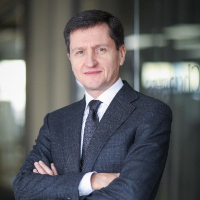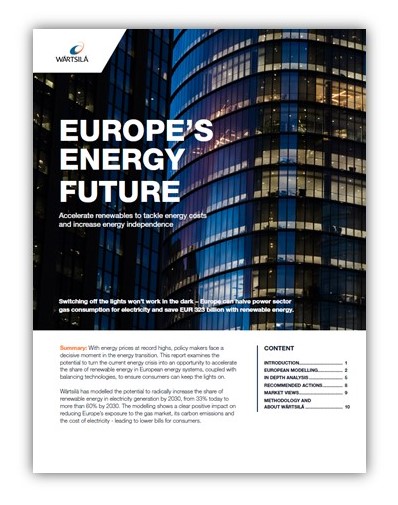

Securing Poland’s energy future
COST AND EMISSIONS REDUCED THROUGH CO-OPTIMISATION OF THE POWER SYSTEM AND DISTRICT HEATING
The energy landscape is undergoing a profound transformation, shifting towards renewable energy sources such as wind and solar to reduce emissions and enhance energy security.
Poland, much like other nations, is grappling with the challenge of lowering carbon emissions and transitioning to sustainable energy sources. For Poland’s coal dominated power system and district heating (DH) networks, this transition poses both challenges and immense opportunities.
Wärtsilä understands these challenges and is dedicated to finding sustainable solutions. We recognise the need to adapt existing systems for greater efficiency. By leveraging our expertise and cutting-edge solutions, we can support the transition to a low-carbon future and contribute to a cleaner and more sustainable Poland.
Our flexible solutions and expert guidance can help local authorities and district heating providers in Poland to enhance energy security and efficiencies while reducing emissions in a cost-optimal way. With flexible district heating technologies balancing intermittent renewables, the country can maximise its utilisation of cheap, zero-carbon energy.
Co-optimisation isn't just a buzzword – it's the key to unlocking unparalleled efficiency. Harmonising Poland’s power system and heat generation in this way reduces both costs and emissions, laying the foundation for a 100% renewable-energy future while advancing energy security and affordability.

Swift, decisive action is needed to secure Poland's energy transition.
Powering Poland’s Future: Optimising the power system and district heating for the next decade
The transition from coal-dominated to majority renewable electricity and heating systems represents a profound transformation. Yet, this study demonstrates how Poland can achieve this over the next decade — while unlocking substantial system cost savings and emissions reductions across both sectors.
To get started, please contact:

Igor Petryk, Market Development Director, Wärtsilä Energy
Email: igor.petryk@wartsila.com
Contact: +358 10 7095676

Sergey Zoubarev, Business Development Manager, Wärtsilä Energy
Email: sergey.zoubarev@wartsila.com
Contact: +358 10 7094525
Gain more insights
Press Release
Poland news
Europe can halve power sector gas consumption for electricity and save EUR 323 billion by doubling new renewable energy, according to Wärtsilä report
Europe can cut its power sector gas consumption in half, reduce energy costs by EUR 323 / USD 356 billion and increase energy independence by 2030 if it rapidly scales up its renewable capacity, according to a new report from Wärtsilä.
To tackle the energy crisis and enable rapid decarbonisation, the technology company is calling on European leaders to implement a monumental but achievable level of cross-country coordination and investment to deliver up to 80GW per year of renewable capacity, backed by flexible balancing technologies.
The ambitious approach modelled in the report would see renewable energy share in electricity generation increase from around 33% today to over 60% by 2030 and would have a direct impact on reducing electricity bills in the short & long term, potentially by up to 10%.
This approach could cut annual power sector gas usage by 52% across the continent by 2030. This can enable the region to avoid 5,456 TWh of gas consumption, equivalent of 3.5 years of Russian gas supply to the EU[i], significantly increasing energy independence.
The report, Europe’s Energy Future, demonstrates how accelerating renewables could also help solve the immediate energy crisis. The modelling of 33 European countries, including 27 EU member states, plus UK, Norway, Switzerland and the Balkans, shows that if renewables are scaled up to 50% of the capacity mix by 2025 then Europe could save EUR 98 / USD 108 billion in energy costs.
Sushil Purohit, President, Wärtsilä Energy and EVP Wärtsilä, said: “Cutting Europe’s dependence on expensive baseload fossil fuels and increasing energy independence need not cost more for power companies or energy consumers. Accelerating the transition to a clean energy system could save EUR 323 / USD 356 billion by 2030 compared to continuing the current pace of renewables growth.
“That is why we are calling for fast decisions to accelerate renewables, tackle the energy price crisis and enable rapid decarbonisation to avert the climate emergency. The time is now.”
To reach the ambitious scenario modelled by Wärtsilä, European countries should collectively add an average 80GW of new renewable capacity each year to 2030.To provide baseload power, wind & solar must be deployed alongside balancing technologies, such as energy storage and future-proof balancing engines capable of running on sustainable fuels.
Wärtsilä modelled two scenarios for Europe’s energy transition over the coming decade. The baseline scenario, based on the IEA’s Renewables 2021 statistics[ii] shows European countries adding 40GW of new renewables capacity every year until 2030 (i.e. the level of deployment currently seen in Europe). This would achieve a 50% share of renewable power by 2030. The ambitious scenario would see double the level of renewables added - 80GW per year, to reach 61% renewable power by 2030.
Carbon emissions are also halved in under the ambitious model, from 911 MMT CO2 in 2021 to 479 MMT CO2 in 2030. This reduction in emissions equates to nearly the entire annual carbon footprint of the UK[iii].
Learn more:
Europe´s Energy Future webpage
Image: Europe’s energy future – accelerate renewables to tackle costs and increase energy independence. © Wärtsilä Corporation
Media contact for more information on this release:
Mirja-Maija Santala
Manager, Marketing & Communications
Wärtsilä Energy
Mob: +358 400 793 827
mirja-maija.santala@wartsila.com
All Wärtsilä releases are available at https://www.wartsila.com/media/news-releases and at http://news.cision.com/wartsila-corporation where also the images can be downloaded.
Wärtsilä Energy in brief
Wärtsilä Energy leads the transition towards a 100% renewable energy future. We help our customers in decarbonisation by developing market-leading technologies. These cover future-fuel enabled balancing power plants, hybrid solutions, energy storage and optimisation technology, including the GEMS energy management platform. Wärtsilä Energy’s lifecycle services are designed to increase efficiency, promote reliability and guarantee operational performance. Our track record comprises 76 GW of power plant capacity and 110 energy storage systems delivered to 180 countries around the world.
https://www.wartsila.com/energy
Wärtsilä in brief
Wärtsilä is a global leader in innovative technologies and lifecycle solutions for the marine and energy markets. We emphasise innovation in sustainable technology and services to help our customers continuously improve their environmental and economic performance. Our dedicated and passionate team of 17,000 professionals in more than 200 locations in 68 countries shape the decarbonisation transformation of our industries across the globe. In 2021, Wärtsilä’s net sales totalled EUR 4.8 billion. Wärtsilä is listed on Nasdaq Helsinki.
www.wartsila.com
[i] https://www.rechargenews.com/energy-transition/the-1-600twh-challenge-the-six-key-steps-needed-to-wean-europe-off-russian-gas/2-1-1180862
[ii] https://www.iea.org/reports/renewables-2021/renewable-electricity?mode=market®ion=Europe&publication=2021&product=Total
[iii] https://assets.publishing.service.gov.uk/government/uploads/system/uploads/attachment_data/file/1051408/2020-final-greenhouse-gas-emissions-statistical-release.pdf



